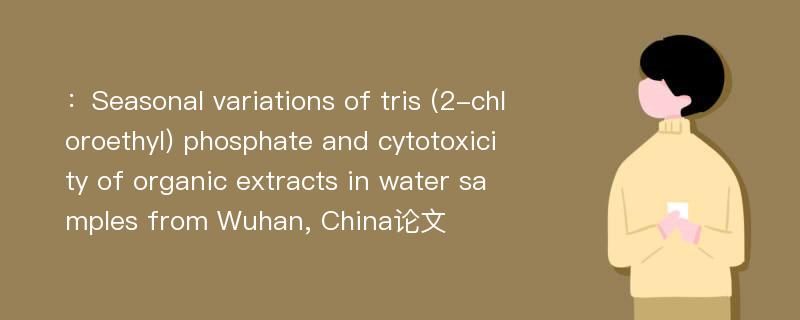
本文主要研究内容
作者(2019)在《Seasonal variations of tris (2-chloroethyl) phosphate and cytotoxicity of organic extracts in water samples from Wuhan, China》一文中研究指出:Tris(2-chloroethyl) phosphate(TCEP) is a typical phosphate flame retardant. Its potential adverse health effects have recently aroused concern. We investigated the seasonal variations of TCEP concentrations in the raw, finished and tap water samples from two drinking water treatment plants(DWTPs) in China, and evaluated the cytotoxicity and apoptosis/necrosis of organic extracts(OEs) in water samples. We enriched TCEP and OEs in water samples by solid-phase extraction method. The TCEP concentrations in water samples were determined by gas chromatography–mass spectrometry. Normal human liver cell line L02 was treated with OEs in the water samples, and then the cytotoxicity and apoptosis/necrosis were measured by 3-(4, 5-dimethyithiazol-2-yl)-2,5-diphenyl-tetrazolium bromide assay and flow cytometry, respectively. The results showed that cytotoxicities of OEs in raw water samples from both DWTPs in summer and winter were stronger than those in spring and autumn, cytotoxicity of OEs in finished and tap water samples from both DWTPs in summer and autumn were stronger than those in spring and winter. In all seasons, the maximal concentrations(100 mL water/mL cell culture) of OEs in the raw water samples from both DWTPs induced late apoptosis/necrosis. The reasons for seasonal variations of TCEP in water samples and potential toxic effects of other pollutants in the water samples need to be further investigated.
Abstract
Tris(2-chloroethyl) phosphate(TCEP) is a typical phosphate flame retardant. Its potential adverse health effects have recently aroused concern. We investigated the seasonal variations of TCEP concentrations in the raw, finished and tap water samples from two drinking water treatment plants(DWTPs) in China, and evaluated the cytotoxicity and apoptosis/necrosis of organic extracts(OEs) in water samples. We enriched TCEP and OEs in water samples by solid-phase extraction method. The TCEP concentrations in water samples were determined by gas chromatography–mass spectrometry. Normal human liver cell line L02 was treated with OEs in the water samples, and then the cytotoxicity and apoptosis/necrosis were measured by 3-(4, 5-dimethyithiazol-2-yl)-2,5-diphenyl-tetrazolium bromide assay and flow cytometry, respectively. The results showed that cytotoxicities of OEs in raw water samples from both DWTPs in summer and winter were stronger than those in spring and autumn, cytotoxicity of OEs in finished and tap water samples from both DWTPs in summer and autumn were stronger than those in spring and winter. In all seasons, the maximal concentrations(100 mL water/mL cell culture) of OEs in the raw water samples from both DWTPs induced late apoptosis/necrosis. The reasons for seasonal variations of TCEP in water samples and potential toxic effects of other pollutants in the water samples need to be further investigated.
论文参考文献
论文详细介绍
论文作者分别是来自Journal of Environmental Sciences的,发表于刊物Journal of Environmental Sciences2019年02期论文,是一篇关于,Journal of Environmental Sciences2019年02期论文的文章。本文可供学术参考使用,各位学者可以免费参考阅读下载,文章观点不代表本站观点,资料来自Journal of Environmental Sciences2019年02期论文网站,若本站收录的文献无意侵犯了您的著作版权,请联系我们删除。
